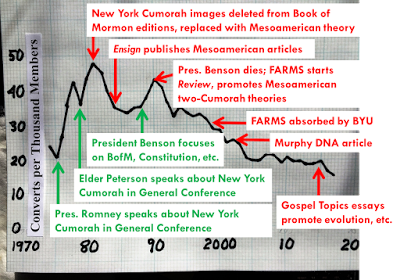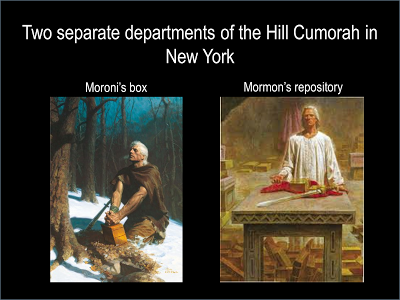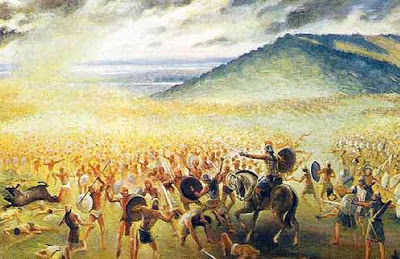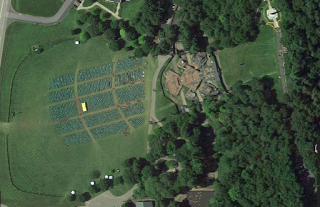"Ignorant of the relevant literature."
Recently I heard a new complaint. Some Mesoamerican supporter claims that I’m “ignorant of the relevant literature.”
I wonder how widespread that belief is. Obviously, it’s a form of cognitive dissonance; i.e., the person believes that I must not be familiar with the “relevant literature” because I don’t agree with his/her views on the topic. IOW, I would be convinced by the “relevant literature” because he/she is convinced by it.
That’s a classic logical fallacy, but it’s not uncommon. It’s similar to the way missionaries can’t understand how anyone could read the Book of Mormon and not be convinced. Or how my Muslim friends can’t understand how people can read the Koran and not become Muslim. Or how Democrats can’t understand Republicans and vice versa.
These differences are not due solely to ignorance of what the other side deems “relevant literature,” although certainly, that may be an important cause for disagreement.
But it’s not the issue with respect to Book of Mormon geography.
Anyone who thinks I’m “ignorant of the relevant literature” should let me know, specifically, what he/she thinks I have not read.
_____________________
The first question is, what is “relevant?”
I have been frankly astonished in the last two years at how ignorant Mesoamerican proponents are of a simple document in Church history: Oliver Cowdery’s Letter VII. Joseph Smith helped write it, had it copied into his personal history, and had it republished so every member of the Church in his day could read and understand it. Letter VII unequivocally declares, specifically as a fact, that the final battles of the Nephites and Jaredites took place in the mile-wide valley west of the Hill Cumorah in New York and that Mormon’s records repository was located there.
Letter VII is the most clear and authoritative statement we have about Book of Mormon geography. It was accepted by all of Joseph’s contemporaries and its teachings have been repeated multiple times in General Conference, including by members of the First Presidency.
Yet today, if you ask a Mesoamerican supporter about Letter VII, you’ll get a blank stare. Actually, you’ll get a blank stare if you ask most Church members, but the Mesoamerican supporters hold themselves out to be better informed and more sophisticated, so their ignorance of Letter VII is inexcusable.
Except, it’s not really inexcusable from the Mesomania perspective.
It’s intentional.
For a Mesoamerican supporter, Letter VII is not relevant. That’s why you’ll never find it in their literature.
Why?
Because it obliterates both the “two-Cumorahs” and the “limited geography Mesoamerican” theories.
Mesomania scholars and educators say Letter VII is not relevant because Joseph and Oliver were ignorant speculators who misled the Church by adopting a false tradition that Cumorah (the Cumorah of Mormon 6:6) was in New York.
Just like that, they explain it away.
Nothing to see here, folks. Move along.
Actually, the Mesomania scholars and educators are doing everything possible to cast doubt on Letter VII. I’ve addressed seven of their arguments on another blog, here: http://www.lettervii.com/2017/01/why-some-people-reject-letter-vii.html
I invite anyone interested in the topic to read Letter VII in its historical context, along with the corroborating statements by every prophet and apostle who has commented on Cumorah, and then decide whether you want to accept the New York Cumorah or accept the Mesomania dogma that Joseph and Oliver were ignorant speculators who misled the Church.
_________________
Some people don’t believe that LDS scholars and educators have suppressed Letter VII. I’d be very interested in any publication or presentation by a Mesoamerican proponent that quotes from Letter VII and analyzes it any differently from the standard claim that Joseph and Oliver were ignorant speculators who misled the Church.
There is really no alternative for the Mesoamerican proponents. That’s why I adapted a Dilbert cartoon that summarizes the psychology involved:
 |
| Mesomania scholars and educators encounter Letter VII |
One good example is the seminal book, In Search of Cumorah by David A. Palmer, which is frequently cited by the citation cartel. Even though his book purports to be about Cumorah, he doesn’t even mention Letter VII by name, let alone quote it for readers (although he does put it in a footnote as part of his claim that Oliver Cowdery first labeled the hill as Cumorah in 1835). Palmer also wrote the “Cumorah” entry in the Encyclopedia of Mormonism, which, of course, also censors Letter VII. It was this article that was plagiarized for an alleged fax from the “office of the First Presidency” that is often cited by Mesoamerican proponents.
Think about this for a moment. Because of Mesomania, the article on “Cumorah” in the Encyclopedia of Mormonism does not even mention that Oliver Cowdery, while Assistant President of the Church, stated it was a fact that the final battles of the Nephites and Jaredites took place in the valley west of the Hill Cumorah in New York, and that Mormon’s repository (Mormon 6:6) was in that same hill. The article doesn’t mention that Oliver himself had visited that repository multiple times, according to Brigham Young and others. This is raw censorship, made worse by the promotion instead of the author’s own theories and his own book.
Although Letter VII was republished in the Messenger and Advocate, the Gospel Reflector, the Times and Seasons, the Millennial Star, and the Improvement Era, it has never been published in the Ensign. Instead, the Ensign has published plenty of Mesoamerican-promoting articles, demonstrating the editorial posture of that magazine.
If not for the Joseph Smith Papers, which had to publish Letter VII only because Joseph had it copied into his personal history, Letter VII would not be available to most members of the Church today. Even then, it’s fairly obscure unless you know what you’re looking for.
Think of this. Most members of the Church might think reading the Encyclopedia of Mormonism, the Ensign, and the Church manuals would give them a solid background in Church history. But Letter VII has been completely censored from these publications.
It can’t be overemphasized that Joseph thought this was important enough to have it republished multiple times so everyone would be familiar with it.
Now, no one knows about it.
Outside of the LDS scholars and educators who know about Letter VII but suppress it, the only Church members who know about Letter VII are those who have read my blogs or my little book or some of the other materials by supporters of the North American geography.
Another good example of censorship is Mark Allen Wright’s otherwise excellent article, published in the Interpreter and elsewhere, titled “Heartland as Hinterland: The Mesoamerican Core and North American Periphery of Book of Mormon Geography.” He writes, “The best available evidence for the Book of Mormon continues to support a limited Mesoamerican model…. I introduce the Hinterland Hypothesis and argue that it can harmonize the Mesoamerican evidence for the Book of Mormon with Joseph Smith’s statements concerning Nephite and Lamanite material culture in North America.” He discusses Zelph and the plains of the Nephites, and while I think his approach is ineffective for several reasons, at least he addresses these issues.
Of course, he never once mentions Letter VII.
_____________________
From the Mesoamerican perspective, Letter VII and other material that support the North American setting for the Book of Mormon are ignored because they are deemed “not relevant.” That’s why Book of Mormon Central, which raised a lot of money on the initial premise that they would be a central repository for all Book of Mormon related research, instead refuses to include anything that does not promote their Mesoamerican ideology.
Actually, they have to do this; their corporate owner, BMAF, has the primary goal “to increase understanding of the Book of Mormon as an ancient Mesoamerican codex.” Obviously, Letter VII would undermine that corporate goal.
To its credit, Book of Mormon Central did upload an early first edition of my little book on Letter VII, which I gave them royalty-free to distribute. But then they uploaded attack articles without giving me a chance to respond, which is exactly how the entire citation cartel has operated for years.
When a Mesoamerican supporter claims I am “ignorant of the relevant literature,” the term “relevant” always refers to “the literature that supports the Mesoamerican theory.”
Anything that contradicts their theories is not considered relevant.
The Mesomania approach would be laughable if only this ideology hadn’t become the “consensus” among LDS scholars and educators.
_______________________
The second question is, what “relevant literature” have I read?
In my college classes, I tell students not to plagiarize because I’ve read the entire Internet and I will recognize anything they copy. It’s a joke, of course, but in the context of Book of Mormon geography, I’ve been reading, studying, listening and attending for decades.
I was raised with the Arnold Friberg paintings, the old CES materials about Ancient America that focused on Central and South America, etc. I still have my old Book of Mormon (pre-1981) that contains not just the photos of the real Cumorah in New York, but photos of artifacts and locations in Central and South America. We used to watch Ancient America Speaks, which you can see on youtube now in English and Spanish.
At BYU, I took a class from Ray Matheny, who appears in the film, as well as John Sorenson and others. Everyone I knew accepted the Mesoamerican theory, especially after the Ensign published Sorenson’s articles in 1984.
Until FARMS was dissolved, I used to read all the FARMS newsletters and publications. I have most if not all of the issues of BYU Studies for the last couple of decades, and I subscribe to the digital version. I’ve read the Interpreter, Meridian Magazine, BMAF, FairMormon, Book of Mormon Central, and many of the related blogs. That’s how I came to realize it’s all a big citation cartel; i.e., the same people quoting one another (and themselves) over and over.
I’ve read all of Sorenson’s books and articles that I’m aware of. Same with the writings of other Mesomania supporters. Same with detractors, who have made some good points, such as the CES Letter and Earl Wunderli’s An Imperfect Book that focus on what I consider the false tradition of Mesomania (as do most critics, including former, non- and anti-Mormon authors).
Early on, I commented on specific articles, but people got offended. I’m not trying to offend anyone. I just want people to consider all the evidence, not just the evidence that Mesomania scholars and educators deem “relevant.” I made my points, so I haven’t done these reviews for a while.
Not that there is a lack of material.
I’ve signed a “comity” agreement which provided that I not name specific individuals, and I don’t want to implicate or offend anyone. (Sorenson didn’t sign it, and anyway it’s difficult to discuss the issue without mentioning him. And I acknowledged his positive influence in Moroni’s America.)
 |
| A few of the books I used in writing The Lost City of Zarahemla |
Let’s just say that any book or article that promotes the Mesoamerican theory and has been cited by the citation cartel is probably in my library, physical or digital, but if not, I’ve read it on loan or online.
Let me repeat: If anyone can think of one they don’t think I’ve read, let me know. Maybe I have overlooked one, and if so, I’d like to know about it.
I have Mesoamerican books that I’ve annotated quite extensively but have never published my comments because we’re all trying to get along and I signed the comity agreement.
Besides, I don’t think beating a dead horse tapir makes sense.
____________________
I’ll finish this post by recognizing the same logical fallacy that I addressed above; i.e., I don’t expect everyone who reads Letter VII to be convinced that Cumorah is in New York.
Plenty of people have read Letter VII and still think Joseph and Oliver were ignorant speculators who misled the Church.
If that’s your opinion, that’s fine with me.
But don’t assume you know everything just because you’ve been indoctrinated your entire life by Mesomania and then reached out to read a few passages from Letter VII, accompanied by all the anti-Letter VII material published by the citation cartel.
I think the vast majority of LDS people will accept Letter VII when they read it, especially when they read it in context. It’s even more persuasive when we study the relevant archaeology, anthropology, geology, geography, etc.
And as always, I welcome your input.
Source: Book of Mormon Wars













